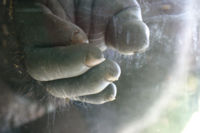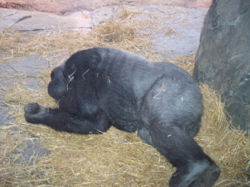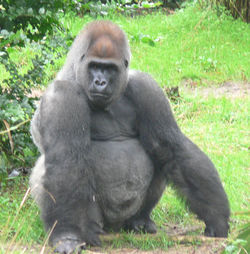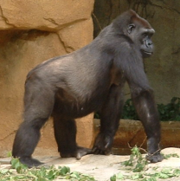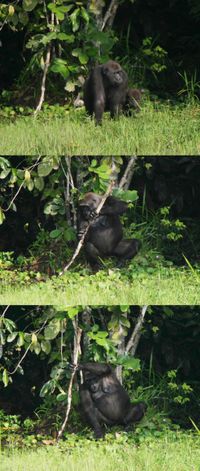Gorilla
2007 Schools Wikipedia Selection. Related subjects: Mammals
| iGorillas | ||||||||||||||||
|---|---|---|---|---|---|---|---|---|---|---|---|---|---|---|---|---|
 Western Lowland Gorilla
(Gorilla gorilla gorilla) |
||||||||||||||||
|
|
||||||||||||||||
 Endangered (EN) |
||||||||||||||||
| Scientific classification | ||||||||||||||||
|
||||||||||||||||
|
|
||||||||||||||||
| Troglodytes gorilla Savage, 1847 |
||||||||||||||||
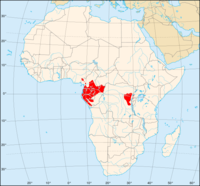 distribution of Gorilla
|
||||||||||||||||
|
|
||||||||||||||||
|
Gorilla gorilla |
The gorilla, the largest of the living primates, is a ground-dwelling herbivore that inhabits the forests of Africa. Gorillas are divided into two species and (under debate as of 2006) either four or five subspecies. Its DNA is 97%-98% identical to that of a human, and is the next closest living relative to humans after the two chimpanzee species.
Name
The American physician and missionary Thomas Staughton Savage first described the Western Gorilla (he called it Troglodytes gorilla) in 1847 from specimens obtained in Liberia. The name was derived from the Greek word Gorillai (a "tribe of hairy women") described by Hanno the Navigator, a Carthaginian navigator and possible visitor (circa 480 BC) to the area that later became Sierra Leone.
Physical characteristics
Gorillas move around by knuckle-walking. Adult males range in height from 165-175 cm (5 ft 5 in-5 ft 9 in), and in weight from 140-200 kg (310-440 lb). Adult females are often half the size of a silverback, averaging about 140 cm (4 ft 7 in) tall and 100 kg (220 lb). Occasionally, a silverback of over 183 cm (6 feet) and 225 kg (500 lb) have been recorded in the wild. However, obese gorillas in captivity have reached a weight of 270 kg (600 lb). Gorillas have a facial structure which is described as prognathous, that is, their mandible protrudes further out than the maxilla.
Gestation is 8½ months. There are typically 3 to 4 years between births. Infants stay with their mothers for 3-4 years. Females mature at 10–12 years (earlier in captivity); males 11–13 years. Lifespan is between 30–50 years. The Philadelphia Zoo's Massa set the longevity record of 54 years at the time of his death.
Gorillas are mainly vegetarian, eating fruits, leaves, and shoots. Insects make up 1-2% of their diet. Due to their diet of plant life, gorillas often have bloated stomachs.
Almost all gorillas share the same blood type (B) and, like humans, have individual finger prints.
Classification
Until recently there were considered to be three species of gorilla, The Western Lowland, The Eastern Lowland and Mountain Gorilla. There is now agreement that the gorilla is divided into two species of at least two subspecies each. More recently it has been claimed that a third subspecies exists in one of these groups.
Primatologists continue to explore the relationships between various gorilla populations. The species and subspecies listed here are the ones most scientists agree upon.
- Genus Gorilla
- Western Gorilla (Gorilla gorilla)
- Western Lowland Gorilla (Gorilla gorilla gorilla)
- Cross River Gorilla (Gorilla gorilla diehli)
- Eastern Gorilla (Gorilla beringei)
- Mountain Gorilla (Gorilla beringei beringei)
- Eastern Lowland Gorilla (Gorilla beringei graueri)
- Western Gorilla (Gorilla gorilla)
The proposed third subspecies of Gorilla beringei, which has not yet received a full latin designation, is the Bwindi population of the Mountain Gorilla, sometimes called Bwindi Gorilla.
Endangerment
Both species of gorilla are endangered, and have been subject to intense poaching for a long time. Threats to gorilla survival include habitat destruction and the bushmeat trade. In 2004 a population of several hundred gorillas in the Odzala National Park, Republic of Congo was essentially wiped out by the Ebola virus.
Behaviour
A silverback is an adult male gorilla, typically more than 12 years of age and named for the distinctive patch of silver hair on his back. A silverback gorilla has large canines that come with maturity. Blackbacks are sexually mature males of up to 11 years of age.
Silverbacks are the strong, dominant troop leaders. Each typically leads a troop of 5 to 30 gorillas and is the centre of the troop's attention, making all the decisions, mediating conflicts, determining the movements of the group, leading the others to feeding sites and taking responsibility for the safety and well-being of the troop.
Males will slowly begin to leave their original troop when they are about 11 years old, travelling alone or with a group of other males for 2–5 years before being able to attract females to form a new group and start breeding. While infant gorillas normally stay with their mother for 3–4 years, silverbacks will care for weaned young orphans, though never to the extent of carrying the little gorillas.
If challenged by a younger or even by an outsider male, a silverback will scream, beat his chest, break branches, bare his teeth, then charge forward. Sometimes a younger male in the group can take over leadership from an old male. If the leader is killed by disease, accident, fighting or poachers, the group will split up, as animals disperse to look for a new protective male. Very occasionally, a group might be taken over in its entirety by another male. There is a strong risk that the new male may kill the infants of the dead silverback.
Studies
- The first reference to gorillas was in the diary/history of Hanno the Navigator, a Carthaginian prince and sailor. There was some debate amongst his men as to whether gorillas were a separate species or just a strange tribe of men.
- 19th Century: The first scientific writings about gorillas dates back to the 1847 Proceedings of the Boston Society of Natural History, where Troglodytes gorilla is described, with a few other species following in the next couple of years.
- Early 20th Century: The next systematic study was not conducted until the 1920s, when Carl Akely of the American Museum of Natural History traveled to Africa to hunt for an animal to be shot and stuffed. On his first trip he was accompanied by his friends Mary Bradley, a famous mystery writer, and her husband. After their trip, Mary Bradley wrote On the Gorilla Trail. She later became an advocate for the conservation of gorillas and wrote several more books (mainly for children). In the late 1920s and early 1930s, Robert Yerkes and his wife Ava helped further the study of gorillas when they sent Harold Bigham to Africa. Yerkes also wrote a book in 1929 about the great apes.
- Mid 20th Century: After WWII, George Schaller was one of the first researchers to go into the field and study primates. In 1959, he conducted a systematic study of the Mountain Gorilla in the wild and published his work. Years later, at the behest of Louis Leakey and the National Geographic, Dian Fossey conducted a much longer and more comprehensive study of the Mountain Gorilla. It was not until she published her work that many misconceptions and myths about gorillas were finally disproved, including the myth that gorillas are violent.
Intelligence
Gorillas are closely related to humans and are considered highly intelligent. A few individuals in captivity, such as Koko, have been taught a subset of sign language (see animal language for a discussion).
Natural tool use by all the "great apes"
The following observations were made by a team led by Thomas Breuer of the Wildlife Conservation Society in September 2005. Gorillas are now known to use tools in the wild. A female gorilla in the Nouabalé-Ndoki National Park in the Republic of Congo was recorded using a stick as if to gauge the depth of water whilst crossing a swamp. A second female was seen using a tree stump as a bridge and also as a support whilst fishing in the swamp. This means that all of the great apes are now known to use tools.
In September 2005, a two and a half year old gorilla in the Republic of Congo was discovered using rocks to smash open palm nuts inside a game sanctuary.. While this was the first such observation for a gorilla, over forty years previously chimpanzees had been seen using tools in the wild, famously 'fishing' for termites. Other animals also use tools, e.g. sea otters use rocks on their chests to break sea urchins. It is a common tale among native peoples that gorillas have used rocks and sticks to thwart predators, even rebuking large mammals. Great apes are endowed with a semi-precision grip, and certainly have been able to use both simple tools and even weapons, by improvising a club from a convenient fallen branch. With training, in 20th Century carnival and circus acts, chimpanzees have been taught to operate simple motorbikes.
Gorillas in pop culture
Giant gorillas have been a recurring theme in film since the 1930s. Following their popularity in the 1930s and 40s, most notably in the films King Kong, Tarzan, and Mighty Joe Young, gorillas came to be heavily featured in comic books. Short contrived gorilla plots were often included so that they could appear on the cover to boost sales.
Gorilla suits are an eternally popular gag costume, appearing in large numbers of TV shows since the 1950s. A number of sports teams have a gorilla as a mascot usually personified by an actor in a gorilla suit.
